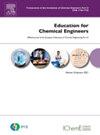开发和实现一个模拟离心压缩机的APP
IF 2.3
2区 教育学
Q1 EDUCATION, SCIENTIFIC DISCIPLINES
引用次数: 0
摘要
仿真是当前化工专业课程中的一门重点学科。本文介绍了一种离心式压缩机仿真装置。目标是在APP格式下开发一个用户友好、高效、计算量低的离心压缩机模拟器。该模拟器考虑了气体的多向性,采用Peng-Robinson方程求解压缩系数。测定了离心式压缩机的破碎马力、叶轮直径、角速度、容积流量和级数。结果表明,大多数离心压缩机的设计参数与文献报道的偏差在2 % ~ 10 %之间。这样,APP的验证就完成了。根据学生的感知,该模拟器的界面设计、功能和性能使他们能够理解可压缩流在离心压缩机设计中的应用。此外,该模拟器可在手动和自动模式下工作,并在具有标准硬件和软件规格的计算机上运行。APP自动模式,用户输入压缩机的物理性能和运行条件,自动生成压缩机的设计方案。在手动模式下,用户需要引入与自动模式相同的数据,而且还需要引入可压缩性因素。手动模式增加了用户与APP的交互性,减少了收敛问题,而自动模式提高了算法的效率。除了确定的学术效益外,该模拟器还可用于工业部门离心压缩机的初步设计。本文章由计算机程序翻译,如有差异,请以英文原文为准。
Development and implementation of an APP to simulate centrifugal compressors
The simulation is a key subject in the current curriculum of chemical engineers. In this paper a simulator of centrifugal compressors is presented. The goal was to develop a user-friendly, efficient and low computationally-demanding simulator of centrifugal compressors under APP format. This simulator was developed considering the polytropic behavior of gases and Peng-Robinson’s equation was used to obtain the compressibility factors. The break horsepower, impeller diameter, angular velocity, volumetric flows and number of stages were determined for the centrifugal compressors. The results disclosed that most design parameters of centrifugal compressors showed deviations between 2 % and 10 % regard those reported in literature. Thus, the validation of the APP is achieved. According to students’ perception, the design of interface, the functionality and performance of this simulator allowed the understanding of compressible flow applied in the design of centrifugal compressors. Besides, this simulator works under both manual and automatic mode and runs on computers with standard hardware and software specifications. Automatic mode of the APP generates the design of compressor once user introduces the physical properties and operation conditions. In the manual mode user is required to introduce the same data as the automatic mode but also the compressibility factors. The manual mode increases the interactivity of users with the APP and reduces convergence problems, while the automatic mode improves the efficiency of the algorithm. In addition to the academic benefits determined, this simulator could be used to generate preliminary designs of centrifugal compressors for industrial sector.
求助全文
通过发布文献求助,成功后即可免费获取论文全文。
去求助
来源期刊

Education for Chemical Engineers
Multiple-
CiteScore
8.80
自引率
17.90%
发文量
30
审稿时长
31 days
期刊介绍:
Education for Chemical Engineers was launched in 2006 with a remit to publisheducation research papers, resource reviews and teaching and learning notes. ECE is targeted at chemical engineering academics and educators, discussing the ongoingchanges and development in chemical engineering education. This international title publishes papers from around the world, creating a global network of chemical engineering academics. Papers demonstrating how educational research results can be applied to chemical engineering education are particularly welcome, as are the accounts of research work that brings new perspectives to established principles, highlighting unsolved problems or indicating direction for future research relevant to chemical engineering education. Core topic areas: -Assessment- Accreditation- Curriculum development and transformation- Design- Diversity- Distance education-- E-learning Entrepreneurship programs- Industry-academic linkages- Benchmarking- Lifelong learning- Multidisciplinary programs- Outreach from kindergarten to high school programs- Student recruitment and retention and transition programs- New technology- Problem-based learning- Social responsibility and professionalism- Teamwork- Web-based learning
 求助内容:
求助内容: 应助结果提醒方式:
应助结果提醒方式:


